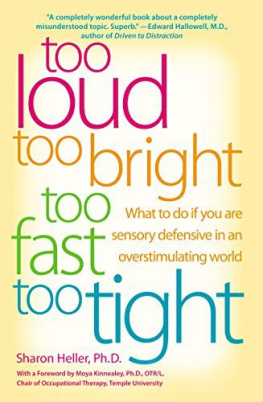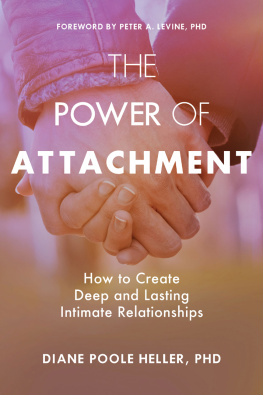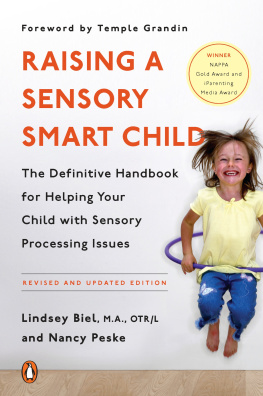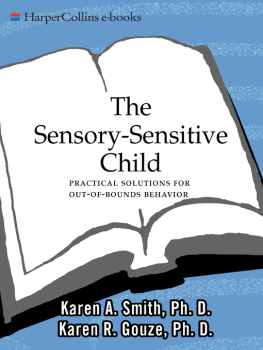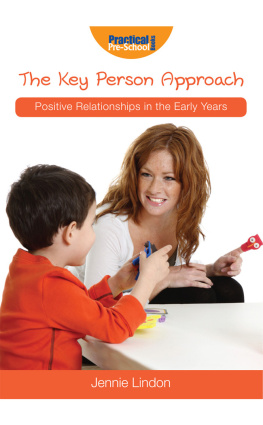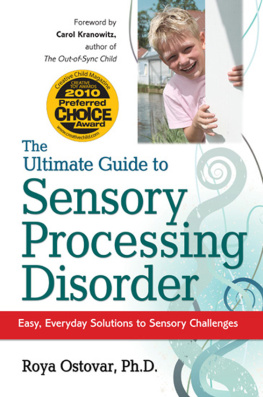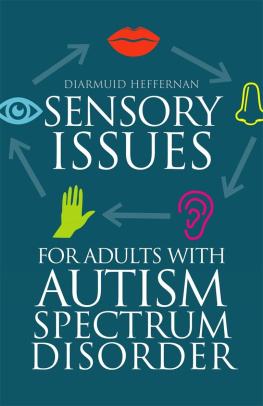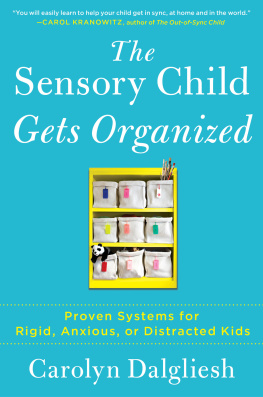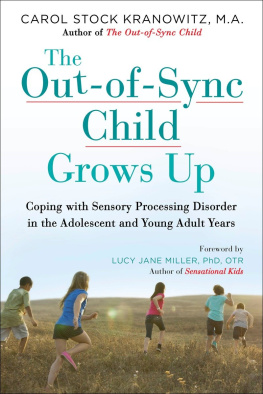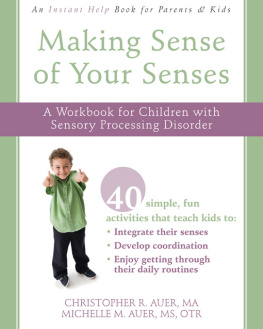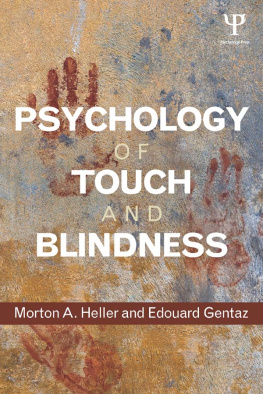
To Robert,
easy, playful, calming
It is very confusing, and very frustrating, to spend so much effort being so afraid to be touched, and working so very hard to avoid being touched, when it is touching and being touched that I need most of all.P AT H OLBROOK
Too Loud, Too Bright, Too Fast, Too Tight
Illuminates an Often Misunderstood Condition
Explains how the tendency to become easily overstimulated has a name and a framework of understanding beyond stress and anxietyExplores the differences between sensory defensiveness and common hypersensitivityExamines why many sufferers are misdiagnosed with such psychiatric conditions as anxiety, panic disorder, obsessive- compulsive behavior, attention deficit hyperactivity disorder (ADHD), depression, or anorexia
Offers a Comprehensive Resource for Sufferers
Helpful for anyone who reacts with irritation and even alarm to ordinary sensation that others can tune out, such as touch, heat, cold, motion, sounds, lights, odors, and tasteAppropriate for sufferers of all ages and levels of severityClear and jargon freeBrings readers up-to-date on the latest thinking and techniques to combat this conditionTeaches sufferers what they can do to minimize sensory over- stimulation and educate othersProvides self-tests and quick and accessible to-do lists for decreasing overwhelming stimuliSuggests sensorimotor activities for daily routines to increase calmness and alertnessShows how to cope with rapidly changing and irritating environmentsProvides a holistic treatment approach that includes strategies from occupational therapy and many other disciplines
Proposes a New Perspective for Understanding Behavior
Explains the crucial role of sensory processing in understanding our behaviorProvides numerous case studies to demonstrate how sensory defensiveness mimics, exaggerates, or results in many psychiatric conditions
Uses Clear and Jargon-Free Language
Written in a lively, engaging style with numerous case historiesGets to the heart of the matter with concisely organized chapters readers can turn to as neededOffers workable, real-world advice from leading clinicians and researchers and Dr. Hellers clinical experience
Contents
I am enormously grateful to Moya Kinnealey, Carol Kranowitz, and Steven Cool for their careful and thorough reading of the manuscript and valuable suggestions, and to Betsy Hancock, Jeannetta Burpee, Judy Kimball, Troy Mills, and Dean Howell for reading and commenting on various sections. My heartfelt thanks to friends Carolyne Singer, Hilary Leibowitz, and Mayo Viscioso for their helpful input.
I want to thank Leslie Stern, my first editor at HarperCollins, for her initial help and encouragement. Gail Winston, my managing editor, was an authors dreamthorough, committed, and efficient. Thanks to my agent, Mary Ann Naples of Creative Culture, for her ongoing support and encouragement throughout.
I greatly appreciate the many sensory-defensive people who allowed me to share their stories. Pat Holbrook, the owner of the chatline Adultsid (adults with sensory integration dysfunction), is an enormously insightful person whose articulate descriptions of her own lifelong struggle with sensory defensiveness greatly enhanced my understanding of this problem and substantially contributed to the writing of this book. I want to thank as well the other members of this chatline who shared their stories.
Lastly, I want to thank occupational therapist Patti Oetter. My therapist at the Ayres Clinic and my mentor over the last seven years, Patti has taught me much of what I know about sensory integration and the problem of sensory defensiveness. She is unusually perceptive and has an extraordinary ability to tune in to others and make one feel shes right there.
Because little has been published on sensory defensiveness, and especially in adults, much of the information in this book came from occupational therapy workshops given by Patricia and Julia Wilbarger, Patti Oetter, Nancy Lawton-Shirley, Sheila Frick, Mary Kawar, Marie Anzalone, and Steven Cool. Conversations with occupational therapists Carolyn Slutsky and Deborah Milam further advanced my knowledge.
This book represents a breakthrough in understanding and describing sensory defensiveness, a condition that affects hundreds of thousands of Americans, and is just now being recognized by the medical, psychological, and educational communities.
The inability to find sensory comfort in our sensorially imbalanced societytypified by fast, loud, bright bytes and few islands of calmmakes everyone feel overwhelmed, exhausted, and stressed. The heightened defensive reactions of people with sensitive sensory systems can severely compromise daily activity and quality of life.
Advice to sufferers has typically been Youll grow out of it, Youll get used to it, or Its all in your head. In this book, the condition is described and named, the physiological roots are identified, and methods of effectively changing the impact of the condition are suggested.
The depth of understanding and the clarity of description which bring the many elusive aspects of sensory defensiveness into focus have typically been within the professional purview of occupational therapists in their work with children with disabilities. Sharon Heller, Ph.D., makes this information understandable and available to us all by providing insight into the lives of adult sufferers so that they and their loved ones who are struggling to cope, as well as helping professionals who are trying to be effective, can better understand this condition.
Heller, a psychologist and a skilled author with several books to her credit, became sensory defensive as a result of a fall. Because she acquired the condition later in life, she is able to recognize its devastating impact. In contrast, people who have been sensory defensive all their lives cannot fathom how significantly their experience differs from that of other people, and, as a result, they blame themselves. As a psychologist, Heller is able to authoritatively describe how this condition can impact emotional well-being and may imitate or contribute to psychological conditions. Her exhaustive research and extensive interviews with sufferers, combined with her readable style, make this work extremely valuable.
In the many years that I have worked with children and adults as an occupational therapist, clinician, educator, and researcher, one issue that stands out is the lack of accurate words for patients to describe feelings of discomfort. Children react by running, hitting, isolating themselves, etc. Adults grimace, make an emotional vocalization, look helpless, and say, There is no wordjust bad, or It is like fingernails on a chalkboard. Since we frequently understand others through our own experiences, people without sensory defensiveness cannot, for the most part, comprehend or empathize with a person overwhelmed by stimuli and professionals outside a small circle are not trained to recognize the condition. The defensive person may be dismissed as odd, high-maintenance, needy, picky, or difficult.
Readers will come away with a new understanding of human behaviorthat the sensory comfort that some people achieve naturally is, for others, a daily, minute-by-minute, lifelong effort that dictates their behavior, affects relationships and intimacy, and leaves them feeling unfulfilled as they search for the reason for their discomfort. This book is a must-read not only for those with sensory defensiveness and their loved ones but for professionals and educators working to understand and enhance the lives of those with whom they work.
M OYA K INNEALEY , P H .D., OTR/L,
chair of the department of occupational therapy, Temple University, Philadelphia, Pennsylvania
Next page
